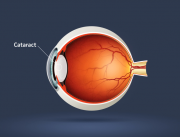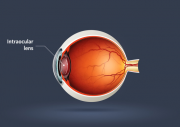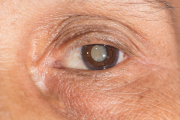Contents |
Cataracts: No Need to Dim Your View of Life
Introduction and Overview
In normal human ocular anatomy, the crystalline lens sits behind the iris (the colored part of the eye). It is normally transparent to allow light to pass through it to reach the nerve cells of the retina (the light-sensitive nerve fiber layer lining the back of the eye).
(In this article, the word "lens" refers to the crystalline lens inside the eye, not to any contact lens or eyeglasses.)
Technically, the definition of cataract is any loss or change in the transparency of the lens; under this definition, most people would be classified as having cataracts, as it is quite normal to see small dots and other tiny opacities that don’t affect vision at all. Practically speaking, a cataract becomes a diagnosis when the tissue is no longer transparent enough to allow us to see normally.
Two interesting facts about the crystalline lens are, (1) that it continues to grow and add layers each year, similar to the growth rings of a tree; and (2) it is enclosed in a capsule, which isolates it from the rest of the body, so if the capsule is broken (by injury, for example) the lens will be rapidly damaged as the immune system goes to work. The immune system acts on the lens as it would on any foreign tissue, because it does not recognize it as the body’s own.
The lens allows us to shift focus from far away to up close and back by contracting muscles arranged around the back of the iris, which, in turn, causes the lens to change its shape.
While we are young, the lens is soft and pliable and can change its shape easily and quickly, but as we age, it becomes stiffer and more difficult for the focusing muscles to affect its shape; this is a result of the added growth as we age. We call this presbyopia, a condition that people usually notice in their early 40s, because it is the reason why most of us need reading glasses or multifocals to do close-up activities like reading or using a computer, when we reach that age.
If you could remove your lens from inside the eye and look at it, it would be about the size of an M & M candy (the plain kind, without a nut in the center).
Cataracts are not the result of a “film over the eye,” as some people think; a cataract effects the lens inside the eye, not outside it. They are painless and almost always develop gradually, usually beginning in one eye before the other.
Causes of Cataracts
There are thought to be several different causes of cataracts, although the consensus of opinion among eyecare practitioners is that UV rays from the sun are implicated. One theory is that because the lens is isolated in its capsule, as natural cell death occurs in the lens tissue, dead cells accumulate, causing blurred or foggy vision. As more dead cells build up in the lens, they also scatter light randomly instead of transmitting it straight onto the retina at the back of the eye. This causes a blurred, unclear image.
Cataracts are generally associated with the aging process, which is indirectly linked to the damage to the lens tissue from UV, as noted above. Nearly half of all people will have a visually significant cataract by the time they are 65 years old.
- Other factors in the development of cataracts can include:
- Family history
- Other medical problems, such as diabetes or alcoholism
- Use of certain medications, such as steroids
- Smoking
- Diet high in salt or sodium
- Long-term unprotected exposure to sunlight
- Eye injuries or complications from previous eye surgery
Vision with cataracts has been compared to trying to see through a frosted window; one can see shapes and movement but the details aren’t visible.
While cataracts are generally associated with aging, they may appear in younger people and even infants, usually as the result of an infection during pregnancy. Traumatic cataracts caused by eye injury can occur at any age, of course.
Symptoms and Signs of Cataracts
People who may be developing cataracts usually notice that their vision has gradually been changing. Specifically, they might experience one or more of these symptoms:
- Blurred vision, without pain
- Glare or light-sensitivity
- Double vision in one eye
- Poor night vision
- Dullness of vision and difficulty recognizing contrast
- Changes in colour perception, especially a yellowish or brownish cast
- Changing eyeglass prescriptions that quickly become outdated
- Need for brighter light to see reading materials
The eyecare practitioner looking at an eye with a cataract forming will see the brownish or yellowish tint in the lens, which is normally clear. Using an instrument known as a slit lamp, the doctor can see through the pupil (the round “window” into the back of the eye formed by the iris) and evaluate the cataract by type, location and stage of formation.
Because cataracts cause the symptoms listed above but develop gradually, most people don’t notice them until they begin to impact their daily lives for such things as driving or reading.
Treatment
The only treatment for cataracts is to surgically remove the lens from the eye. There is no medication or supplement which will reverse them, but fortunately, cataract surgery is widely considered to be one of the safest and most effective surgeries done today. Some eye surgeons specialize in cataract removal and get very good at doing this procedure.
If you think you may have cataracts, see an eyecare practitioner for an evaluation and help in finding a good surgeon.
During the past two or three decades, cataract surgery has made great improvements over earlier techniques. Once the lens has been removed, the surgeon will implant a surgical plastic replacement called an intraocular implant (IOL). The power of the IOL will be calculated so that most patients will be much less dependent on wearing eyeglasses than they were before their cataract surgery, a much-appreciated added benefit.
Once the cataracts have been removed, patients immediately notice that their vision is not only much more clear than before, but that colours are brighter and they are more able to see and appreciate contrast. Night vision will also be improved.
A little history: at one time, cataract surgery was a terrible experience, resulting in the permanent loss of clear vision and requiring patients to depend on high-powered eyeglass lenses to replace the lens that was removed; IOLs had not yet been invented, so the eye was left extremely farsighted. Because of this, patients were always advised to wait until their cataracts were “ready” or “ripe” before surgery was done, so most people with cataracts would be legally blind before the surgery. Complications as a result of cataract removal were expected.
Today, most cataract surgeries take less than ten minutes per eye and result in much better vision. The surgery requires only a very small incision, which heals without irritating stitches under the upper eyelid. Patients can have cataract surgery much earlier in the process, at a stage much less visually compromised, and complications are rare.
Most surgeons prefer to do cataract surgery one eye at a time, with a short time (about two weeks in most cases) between them. Patients notice improved vision immediately, because the eye isn’t even patched temporarily; after a short time the surgeon will check the results and patients walk out of the surgery center with better vision than they walked in.
Some people with a large amount of nearsightedness elect to have the lens removed and replaced with an IOL, even in the absence of cataracts, as a type of refractive surgery. Essentially, clear lens extraction (CLE) is the same procedure as is done in removing a cloudy lens, only it is done so the IOL can create an eye that no longer has the nearsightedness. People who have high myopia are not good candidates for LASIK surgery but the CLE provides an end result of much-reduced dependence on eyeglasses or contact lenses.
Prevention
Current wisdom among eyecare practitioners is that everyone will eventually develop cataracts over their lifetime. There is no proven regimen or supplement that always prevents cataract formation, but most eyecare practitioners believe that eating a healthy diet including antioxidants like spinach, broccoli, almonds and eggs is helpful to delay cataract formation. Vitamin E and C supplements may be useful, too.
Probably the two most effective means of delaying the onset of cataracts are (1) Protect the eyes from all UV rays from the sun by good-quality UV-blocking sunglasses, preferably in a wrap-around style that provides good coverage over the entire visual field. Eye protection with sunglasses and a large-brimmed hat when out in the sun should start very early in life, even in infancy, as sun damage accumulates over a lifetime. (2) Do not smoke! Smokers are three times as likely to develop significant cataracts over those who are not.
Changed View of Cataracts
Cataracts are no longer considered to be the devastating diagnosis that they once were. Yes, most of us will eventually develop cataracts and a majority of those will require surgical intervention, but the good news is that this type of surgery is considered to be one of the safest in terms of complications or adverse events. On the whole, most patients gain better vision than they had before, and end up with less dependence on eyeglasses or contact lenses as a bonus.
Cataract surgery is still a type of surgery, however, and as such has a small chance of complications such as infection or other adverse events, so it should not be undertaken lightly or without due thought.
Check with your eyecare practitioner if you think you might have cataracts forming because having your eyes and vision checked is the only way to find out for sure. Follow his or her advice on what to do about surgery, if it’s necessary, and how to go about scheduling it with a surgeon.
Cataracts no longer have to dim your view of life.





